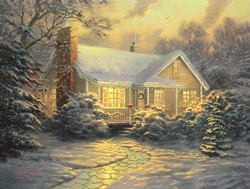
When the "Painter of Light," Thomas Kinkade, died last Friday, the aesthetic merits of his work -- or lack thereof -- were once again up for debate. As the LA Times wrote...
The death of popular artist Thomas Kinkade is certain to ignite controversy regarding the painter’s legacy. Known for his renderings of luminous landscapes and street scenes, often captured at twilight, the so-called painter of light, a Christian who said that God guided his brush, died Friday at 54 of natural causes.
Regarded as both a master of kitsch and a genius of commercial marketing, Kinkade, a graduate of Art Center College of Design in Pasadena, discovered a lucrative formula for his art at an early age. He and his wife, Nanette, initially sold his painting for $35 apiece. Saturday morning on EBay, a 30-by-48-inch canvas of a stormy mountain range by Kinkade was listed at $95,000.
The San Jose Mercury News wrote...
His paintings are hanging in an estimated one of every 20 homes in the United States. Fans cite the warm, familiar feeling of his mass-produced works of art, while it has become fashionable for art critics to dismiss his pieces as tacky. In any event, his prints of idyllic cottages and bucolic garden gates helped establish a brand -- famed for their painted highlights -- not commonly seen in the art world.
Kinkade was born in Placerville, went to Cal, and lived in Los Gatos. In 2006, the artist was accused of unethical business practices by some former gallery owners, and in 2010 his company filed for bankruptcy as the recession took its toll. But now that he's gone, his paintings are apparently flying off the walls at Kinkade galleries around the Bay Area -- and the country.
Whether you can even entertain the idea that Kinkade was a great artist probably depends on your view of the notion that the aesthetic value of a work of art is in the eye of the beholder. Because clearly, many people beheld something they liked. Here's one Miller-McCune piece that treats Kinkade's work in a serious fashion and talks to a couple of art history professors about its appeal.
“Kinkade’s work participates in this vision that there was a world that was Edenic and perfect, and if we could only get back to that, things would be perfect again,” Rager says. The world Kinkade — who referred to himself as born-again — portrays “is not in any way real,” she adds. “It’s a pastiche of concepts from that Edenic past.”
Unlike so many of her colleagues, Boylan doesn’t find that approach reflexively off-putting. “We can’t have it both ways,” she insists. “We can’t be in a country in which we say, ‘Artists have to fight in the marketplace,’ and then when an artist fights in the marketplace and finds success, dismiss them by saying, ‘They’re not my romantic ideal of a starving artist.’
“Matisse at one point said he wanted to create art that was like an armchair that people could fall into. ‘Soothing’ is not how a lot of people would define a lot of the art you see in museums and galleries, but historically, a lot of art has been produced with the sole purpose of being beautiful and comforting, and giving people pleasure.”
Below we present two views of Kinkade, the first from the author Joan Didion, who wrote of him in a 2003 memoir. Her description of the bucolic dwellings depicted in his work as “sinister, suggestive of a trap designed to attract Hansel and Gretel," has been widely cited over the last few days.